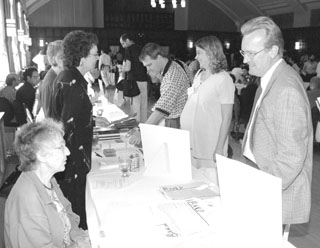The University Record, September 7, 1999 By Mary Jo Frank
Office of Communications

The U-M is more like a zany Dr. Seuss book—where you wear millions of hats and they keep changing—than Hollywood’s stereotype of the quiet, idyllic campus, Provost Nancy Cantor told new faculty last week. “There’s nothing ‘Mr. Chips’ about Michigan. It is not that kind of place,” she promised.
With its 19 schools and colleges and numerous interdisciplinary centers, the University is a “fabulous Byzantine place” that operates at an extraordinarily frenetic pace, partly because of its scale and size, Cantor explained.
Cantor, President Lee C. Bollinger and other administrators welcomed 150 faculty to their new academic home at a Sept. 1 orientation. The newcomers attended programs on a variety of topics and participated in roundtable discussions. Offered for the first time this year, the roundtable sessions brought new and experienced faculty together in small groups to talk about what to expect as a first-year teacher at Michigan, explained Constance E. Cook, director of the Center for Research on Learning and Teaching (CRLT) and associate professor of education. CRLT and the Office of the Provost sponsored the orientation.
At an information fair, 33 campus offices—including the Benefits Office, Family Care Resources Program, Technology Management Office and University Stores—staffed display tables around the perimeter of the Michigan League Ballroom. New faculty members asked questions about University Library services, faculty governance, computer support and recreational opportunities, and loaded up with brochures, copies of the Faculty Handbook, key chains and plastic coasters.
Opera singer Stephen Lusmann, new to the School of Music faculty, said he came away from the orientation program impressed with the University’s tremendous diversity.
“Students come from different socioeconomic and ethnic backgrounds, but they all come with the intellect and desire to learn, and faculty come with a desire to teach. I met some wonderful people. I’m really inspired,” said Lusmann who moved here from Princeton, N.J, and will teach voice.
Margaret Howard, a former broadcast journalist who earned a Ph.D. from the U-M in December 1998, said a program by Barbara J. O’Keefe, director of the Media Union and professor of information, about technology-enhanced learning was one of the best she has ever attended. Howard, who will teach courses in LS&A about the American political process, political parties, and mass media and public opinion, said O’Keefe shared new ways faculty can use technology and Web access to communicate with students.
Janice Barnes, who was an assistant professor at Tulane University before coming to the U-M to do doctoral work, said she was pleasantly surprised at the number of resources available to new faculty and impressed with the willingness of everyone to reach out and help. Barnes will teach in the A. Alfred Taubman College of Architecture and Urban Planning.
In his welcoming remarks, Bollinger told the new faculty, “We are devoted to you. We want to make your career as satisfying and fulfilling as possible.”
Bollinger, who each fall teaches an undergraduate course on freedom of speech and the press, recalled his early days as a teacher, including the terrors of the classroom “where students can be merciless in their candor about how well we do.” He noted that while developing a field of expertise, faculty acquire a screen or filter through which to understand the larger world. “This is one of the gifts the academic community gives—a way to understand life.”
Having absorbed a significant amount of knowledge in their field, it is now time to discover something new and communicate it to others, Bollinger told the faculty. “This need to make a contribution calls for a shift in how one thinks of oneself,” he added.
Cantor invited the new faculty members to participate fully in the life of the University. “If you don’t take part, you’ll miss a lot, and we’ll miss a lot as an institution. At Michigan, the canons are constantly changing. It is a place where perspectives clash,” Cantor said. She described the U-M “as a place that is committed to a diversity of intellectual experience and where people make themselves vulnerable.”
For Deborah Wilkinson, it was the University’s support of interdisciplinary work that convinced her to leave a faculty position at the University of Kansas to join the School of Social Work. Interested in maternal and child health and public health, she looks forward to working with both social work and public health students at the U-M.
“Besides, I love cold weather,” Wilkinson said.

